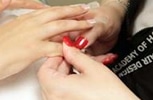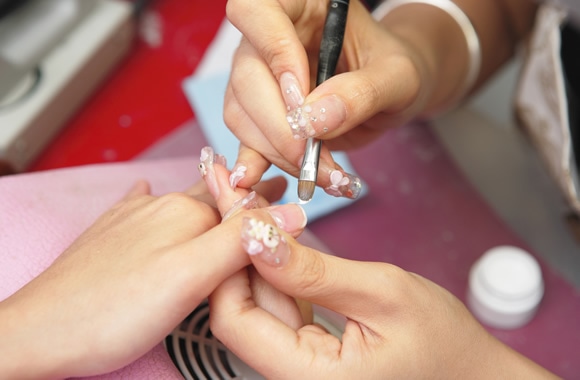
How to Become a Manicurist


Significant ongoing growth in the field of spa and beauty means career opportunities for qualified manicurists.
The spa and beauty industries, in general, experienced considerable growth and shows no signs of slowing down. In the U.S., the spa industry grossed a record $14 billion, while in Canada, it has seen an average annual growth rate of 17 per cent. With the growth comes a need for qualified spa and beauty professionals, including manicurists. Kim Thompson, spa director at The Academy of Hair Design in Springfield, Missouri, offers some insight and advice for anyone who is interested in learning to become a professional manicurist.
What Does a Manicurist Do?
Depending on the province or state where you study and work, you’ll be able to perform a number of approved services, including acrylic & UV Gels, manicures, pedicures, electric filing, and nail art. You’ll also learn about health and safety.
“Sanitation and disinfection is huge in the nail industry because the risk of infection,” says Thompson.
Any manicurist program should cover health issues as well. For example, Thompson says, nail diseases and disorders should be a part of any curriculum and students should also be trained to identify and how to proceed when a guest is found to have an issue. Students should also learn how to handle specific situations—for example, giving manicures and pedicures to pregnant clients or diabetic clients, who require special care and accommodations.
At the Academy of Hair Design, as with most colleges that offer esthetics programs, the practical portion of the training gives students the opportunity to perform services on the general public through walk-ins and appointments. Thompson says this kind doesn’t just provide students with a chance to hone their skills, but also to get some real-world experience and learn more about the value of customer service.
“The practicum exposes the students to making appointments, where they learn the importance of being prepared and on time for the guest,” says Thompson. “It also introduces students to the process of no-show appointments, rescheduling, and rebooking their next appointments.”
Is This Career Right For Me?
Working as a manicurist requires more than a knowledge of how to perform manicures and pedicures. Because of the positions that are maintained for long periods of time, you’ll need to familiarize yourself with proper ergonomics in order to minimize the possibility of developing back problems or carpal tunnel syndrome. This means training yourself to keep feet on the floor with your back straight and using an ergonomically correct chair that allows you to best position yourself for different heights and angles.
You’ll also learn how to stay healthy and safe while using the chemicals that are part of manicuring—like polishes (Phthalates), polish removers (Acetone), nail glue (Tuluene), nail glue removers (Acetonitrile), disinfectants, nail hardeners, primers and more. You must be comfortable working around the tools of the trade and learn to keep your space well-ventilated, follow product directions to the letter, and disinfect properly to remove any chemical residue from your work space.
On a more personal level, Thompson stresses that it’s all about customer service and good customer relations in the spa industry. Manicurists, she says, should be “personable, have an upbeat personality, be creative and patient and have a good work ethic.”
Time management is also crucial, she says, as is a close attention to detail.
Where Are The Jobs?
With the spa and beauty industries experiencing steady growth, manicurists and other beauty professionals will continue to find employment. Thompson suggests combining manicuring with another license to maximize your chances of finding work.
“Manicuring can be a great stand alone career,” she says, “but to pair it with another license, such as esthetics, is an excellent option. Obtaining multiple licenses makes a person more valuable to their employer, as it allows that employer to utilize all of their skills versus hiring multiple employees.”
Self-employment is an option, but Thompson says employment is most traditionally found in nail and hair salons, resort spas, day and medi spas as well as hotels and cruise ships. Mobile manicurists can work in the comfort of the client’s own home, in hospitals, offices and even work bachelorette parties, birthdays, conventions and more.


Leave a Reply